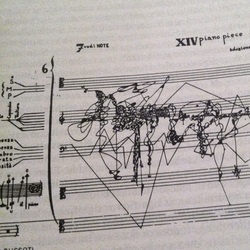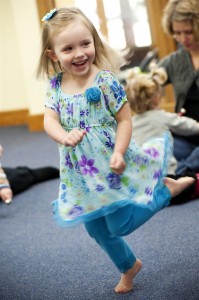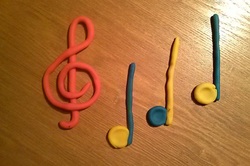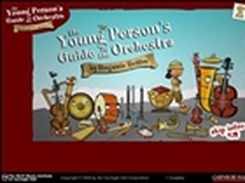Musical Notes
Create successful practice, explore a composer's historical lifestyle, learn about modern composers, experience local performances - Musical Notes will enhance your music education and capture your imagination. Be Inspired!
|
Dean Zimmer has become a bit of a phenomenon these days. He is a gifted drummer who plays with a great deal of passion and skill. Although those attributes are rare, what has set him apart is his ability to overcome his physical limitations. Dean is truly an inspiration! His hands are deformed and he uses a wheelchair to get around, but none of these things keep him from doing what he loves.
This video chronicles a reply to an ad for a drummer. Dean actually struggled up a flight of stairs to respond to the ad. Ever thought about quitting? I think Dean Zimmer will motivate you to continue on in your passion
1 Comment
 As a student, there were times when I was positively certain that the musical notes on my newest lesson pages decided to get up and move around the grand staff as I headed home after my piano lesson! When I sat down to practice, I just could not get that music to sound as good as it had at my teacher's house - it didn't even look the same. Do you ever feel that way? Here are some simple, but important steps, to remember as you begin to practice your new piano piece at home for the first time... Split your piano music into several sections. (No, I'm not suggesting that you tear up your music pages!) Try to find several different sections within the music. Perhaps you can learn it line by line. Or maybe the song easily divides into phrases. You can always ask your teacher for help if you're stuck! Learn each hand one at a time. For most of us, our hands need to learn to work together at the piano! Once each hand is comfortable playing it's part, then you can slowly put them together. Sing as you play! If you know the melody of the song you are trying to learn, don't be afraid to sing as you play. Singing will help you know if you're hitting the right notes and if you're using the correct rhythm. Don't try to play the entire piece at once. We all like to be able to sit down and play our piano piece successfully from beginning to end, but that's not usually possible with a new piano piece. So, don't get frustrated! Take those sections that we mentioned earlier, and learn them one by one - then, put them together one section at a time. It's like a puzzle! Okay, go and apply those ideas to your newest musical assignment! Join us again tomorrow, when we discuss more tips on learning a piano piece for the first time.  As the weather gets cooler, Kindermusik is a great source for indoor fun on a chilly day! Besides helping your little one exhaust his seemingly endless supply of energy, music and movement have been shown to increase learning and get the brain engaged. That being said, here are some excellent musical activities to incorporate into your day: Finger plays like the Insy Winsy Spider are great for tiny hands. The movement activates little fingers, and helps fine motor development. And a song about a spider - a perfectly fun topic for little minds! Our toddler music classes introduce a creative new finger play in each one of our Kindermusik Wiggle & Grow units. Free dancing along to music is an activity that most kiddos thoroughly enjoy - and if you add a favorite teddy bear, the fun grows! Your child is not only loosing some of that pent up energy, but she's also developing her brain by coming up with creative movement that goes along with the music she's listening too. For added inspiration, make sure your playlist has a variety of musical styles! Rocking and swaying to calming music can be wonderful ways to calm your little one and help him prepare for a nap or for bedtime. In fact, you may want to make it a regular part of your bedtime routine. Many of our weekly activities can be successfully enveloped into your daily routine at home. Whether you have a structure time for music and movement or you simply play music throughout the day, your child will benefit greatly from music in her life! If you haven't already, come join us for a free preview Kindermusik class!  Did you know that toddler music classes can have an impact on early math development? Here are three benefits sited by Kindermusik International: Spatial awareness refers to an individual's ability to recognize himself in space - to be aware of the objects around him and his relationship to those objects. This type of reasoning seems to develop more quickly for children who are involved in music classes. Pattern recognition is another area where children can develop more quickly when involved in toddler music classes. And no wonder! Listening to music is a great workout for the brain! Our minds need to recognize and organize the rhythms and melodies to fully enjoy the music. And we take it a step further when we clap to a steady beat, dance along to the rhythm or use our instruments to play along! Counting by rote requires repetition. There are many songs in the Kindermusik curriculum that make the memorization of numbers fun. For example, in our Time for Lunch unit, your toddlers learn to count to eight as they sing One Potato, Two Potato while creating an imaginary pot of yummy soup! Music and math seem to go hand in hand - especially in the toddler music class. If you haven't already, contact us and schedule your free Kindermusik preview class!  Originally posted on Kindermusik's Blog, Minds on Music! What’s in a Kindermusik class… for parents??? Well, for starters, there’s music, singing, instruments, dancing, and together time with your child – the very kinds of music education activities your child will love too. The real secret is that you can enjoy letting out your inner child and everyone else will only be thinking what a wonderful and interactive parent you are! But it really goes much deeper than that. Kindermusik educators are quite fond of explaining that Kindermusik classes are just as much for the parent as they are for the child during this critical window of early childhood development. While there are many benefits of Kindermusik enrollment for you and your child, one significant area is the social-emotional impact for the parents. The Social Outlet Kindermusik classes give you a vital social outlet, a place where you can make new friends and keep up with old friends too! The Support Network Kindermusik is a place where you can belong and be supported by other parents going through the same things with their children as you are with yours. The Emotional Connections Kindermusik classes are where emotional connections between you and your child are strengthened, and where what you learn and enjoy in class will spill over into even more bonding and memories together at home. The Window into Your Child One of the unique features of Kindermusik is that you will glean tidbits and insights into that precious little person that is your child. We use music as the vehicle to enhance every aspect of early childhood development, and to give you a peek into the wonders of the whys and hows of who your child is and what he is becoming. The Best Choice Knowing you have chosen one of the very best possible experiences for your child by enrolling her in Kindermusik makes you feel great – in class each week and at home all week long! See for yourself why so many parents love Kindermusik – for their children and for themselves! Try a free class today. - Written by Theresa Case who has an award-winning Kindermusik program at Piano Central Studios in beautiful Upstate South Carolina  My boys and I love to play with playdough - The only problem we run into is that I like to keep the colors separate and they like to mix them together. Oh well!!! In early childhood education and elementary school - including piano lessons - playdough provides some wonderful benefits for youngsters: creative thinking, eye-hand coordination, fine motor skills, etc. You probably watch each week as I point out a wide variety of musical symbols to your child! We talk about how "a quarter note gets ONE count," "a rest means that we have to be quiet," "the treble clef means we use our right hand to play," etc, etc, etc! Occasionally we use crayons to color these symbols, or we search for them on a page filled with musical notation. Playdough is just one more way to review these important theory symbols with your budding musician - whether they like to mix colors or not! Have them fashion a green bass clef followed by pink quarter notes, and complete the rhythm pattern by adding bar lines - don't forget the double bar line at the end. They can even make those quarter notes go up and down on the table as they sing the melody of a song! A little person's creativity is boundless - and they aren't bothered with how things are "supposed to be done." They're learning and discovering new things everyday! So, pull out that playdough and spend some time creating music with your child. You'll probably be amazed at how many musical symbols they remember from their lessons!  Originally Posted on Kindermusik's Blog, Aug 12, 2013 One of the fabulous benefits of your enrollment in Kindermusik is Kindermusik@Home – a whole new way to access and enjoy your Home Materials throughout the week. But how can Kindermusik@Home make parenting a little bit easier? Well, you might turn to Kindermusik@Home when you…
 The Instruments have gone missing - and it's your job to find them! Join Violet on an instrument safari, guided by her venerable uncle Ollie, and help her collect all the instruments of the orchestra. You'll hear strains of Benjamin Britten's The Young Person's Guide to the Orchestra, and the full version once the instruments are all found! Click here to play. (Ages 7 and up) |
Jessica's Piano Studio
Jessica B.
Teacher at Jessica's Piano Studio to many talented students! Here's some helpful tips and interesting information to create a wonderfully educational musical experience! Archives
March 2015
Categories
All
|